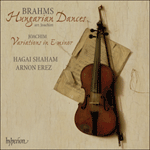
Welcome to Hyperion Records, a British classical label devoted to presenting high-quality recordings of music of all styles and from all periods from the twelfth century to the twenty-first.
Hyperion offers both CDs, and downloads in a number of formats. The site is also available in several languages.
Please use the dropdown buttons to set your preferred options, or use the checkbox to accept the defaults.

| Hagai Shaham (violin), Arnon Erez (piano)» More |
A new and pensive melody, sung by the violin over the theme’s original harmonies, forms variation 10 and leads to two expressive major-key variations (11 and 12) which, with 10, form a kind of central ‘slow movement’ in the sequence. The momentum picks up over the next four variations (13–16), culminating in another ‘hunting’ variation (17) shared between violin and piano. Variation 18 forms the introduction to the finale, a lively movement founded on a new violin theme that goes in combination with the original theme in the piano. This is a kind of rondo (and here Joachim again indulges in explicit colouring all’Ongarese) that races to a brilliant conclusion in E major.
from notes by Calum MacDonald © 2008
Dans la variation 10, le violon chante une mélodie nouvelle, pensive, par-dessus les harmonies originales du thème avant deux variations en majeur (11 et 12). À elles trois, ces variations forment une sorte de «mouvement lent» central dans la séquence. Puis l’élan s’affirme au fil des quatre variations suivantes (13–16) pour culminer dans une seconde variation «de chasse» (17) partagée entre violon et piano. La variation 18 forme l’introduction au finale, un mouvement enjoué fondé sur un nouveau thème violonistique qui se combine avec le thème original au piano. Il s’agit d’une sorte de rondo (là encore, Joachim prend plaisir à une couleur explicitement all’Ongarese) qui se précipite vers une conclusion brillante, en mi majeur.
extrait des notes rédigées par Calum MacDonald © 2008
Français: Hypérion
Eine neue und nachdenkliche Melodie, die von der Violine über die ursprünglichen Harmonien des Themas vorgetragen wird, charakterisiert die Variation 10 und leitet zu zwei ausdrucksstarken Durvariationen (11 und 12) über, die zusammen mit der zehnten Variation in der Gesamtabfolge eine Art „langsamen Mittelsatz“ bilden. Im Verlauf der nächsten vier Variationen (13–16) nimmt das Tempo wieder zu und erreicht in einer weiteren Jagdvariation (17) einen Höhepunkt, die sich Violine und Klavier teilen. Variation 18 bildet die Einleitung zum Schlusssatz, ein lebhafter Satz, der auf einem neuen Violinthema beruht, das mit dem vom Klavier vorgetragenen Ausgangsthema kombiniert wird. Hier hat man es mit der Art von Rondo zu tun (und wieder gönnt sich Joachim eine unverhohlene Farbenfreude all’Ongarese), das einem leuchtenden Abschluss in E-Dur entgegenstrebt.
aus dem Begleittext von Calum MacDonald © 2008
Deutsch: Elke Hockings
 Brahms & Joachim: Hungarian Dances Brahms & Joachim: Hungarian DancesThe forty-year friendship between Brahms and Joseph Joachim, violinist and composer, was one of the most significant and fruitful relationships in nineteenth-century music. Joachim’s transcriptions of Brahms’s famous Hungarian Dances constitute a kin ...» More |

